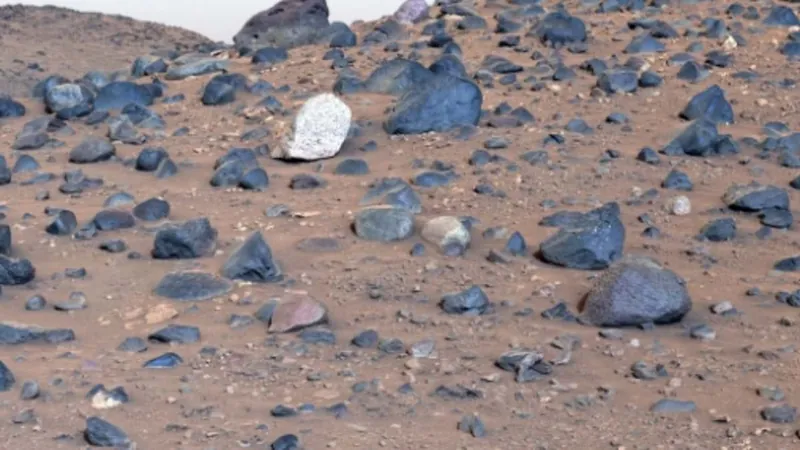
NASA Unveils Mind-Blowing Image of Blue Rocks on Mars – What Secrets Do They Hold?
2024-10-07
Author: Jia
NASA Unveils Mind-Blowing Image of Blue Rocks on Mars
NASA has amazed the world once again by unveiling the clearest image of Mars to date, revealing an extraordinary landscape dotted with striking blue rocks. This groundbreaking footage, captured by the Perseverance rover, showcases a unique geological formation on a dried ancient lakebed, tantalizing scientists with clues about the planet’s past.
The rover, which has been traversing the Jezero crater—an area once teeming with water approximately 3.7 billion years ago—has provided new insights into Mars' geology. In this stunning image, dark blue, irregular boulders of volcanic basalt surround a conspicuous white rock, the likes of which NASA scientists have never encountered before.
Mount Washburn: A Nod to Earth’s Wonders
In a nod to Earth's natural wonders, NASA's team has named this rocky area 'Mount Washburn,' reflecting the beauty of a mountain in Yellowstone National Park. The geological diversity of the region suggests it was once a fertile environment, with ancient rivers depositing fine-grained sand and clay—a perfect recipe for fossil preservation.
Excitement Over the Discovery
One of NASA's planetary geologists, Dr. Katie Stack Morgan, remarked on the intrigue this Martian landscape evokes. "Every once in a while, you'll just see some strange thing in the Martian landscape, and the team is like, 'Oh, let's go over there!'" she stated, highlighting the thrill of exploration.
Dr. G. Jeffrey Taylor, a planetologist from the University of Hawaii, explained that most of the bluish-black rocks on Mars are volcanic basalts, akin to those forming the oceanic islands and mid-ocean ridges on Earth. However, the eye-catching white rock, which measures about 18 inches wide and 14 inches tall, initially astonished researchers.
Atoko Point: The Unique White Rock
NASA has dubbed this exceptional white rock 'Atoko Point,' after a prominent cliff in the Grand Canyon. The discovery was made possible by Perseverance's Mastcam-Z, a sophisticated camera system capable of producing high-resolution 3D images, with a quality comparable to that of consumer digital cameras. These clear images allow scientists to study Martian geology like never before.
What sets 'Atoko Point' apart is its chemical signature. Through comprehensive analysis using SuperCam—Perseverance's suite of geological tools—scientists found an abundance of feldspar, confirming it as Anorthosite, a rare rock type theorized to exist on Mars but never before documented. This significant finding raises questions about the geological history of Mars, including whether this rock was transported by ancient rivers or formed deep underground from volcanic activity.
Implications for Martian Geology
Dr. Stack Morgan expressed excitement over the implications of this discovery for understanding the Martian crust. "Seeing a rock like Atoko Point is one of these hints that, 'Yes, we do have anorthosites on Mars,'" she explained.
As Perseverance continues its mission in Jezero crater, each discovery fuels curiosity about Mars' early environments and its potential to host life. Scientists are hopeful that future findings will illuminate the planet’s geological past, revealing a deeper narrative about how the Red Planet evolved and perhaps hinting at the existence of ancient life forms.
Future Exploration and Curiosity
Could this new data reshape our understanding of Mars and its capacity to support life? Stay tuned as NASA continues its quest to unlock the secrets of our neighboring planet!


 Brasil (PT)
Brasil (PT)
 Canada (EN)
Canada (EN)
 Chile (ES)
Chile (ES)
 España (ES)
España (ES)
 France (FR)
France (FR)
 Hong Kong (EN)
Hong Kong (EN)
 Italia (IT)
Italia (IT)
 日本 (JA)
日本 (JA)
 Magyarország (HU)
Magyarország (HU)
 Norge (NO)
Norge (NO)
 Polska (PL)
Polska (PL)
 Schweiz (DE)
Schweiz (DE)
 Singapore (EN)
Singapore (EN)
 Sverige (SV)
Sverige (SV)
 Suomi (FI)
Suomi (FI)
 Türkiye (TR)
Türkiye (TR)